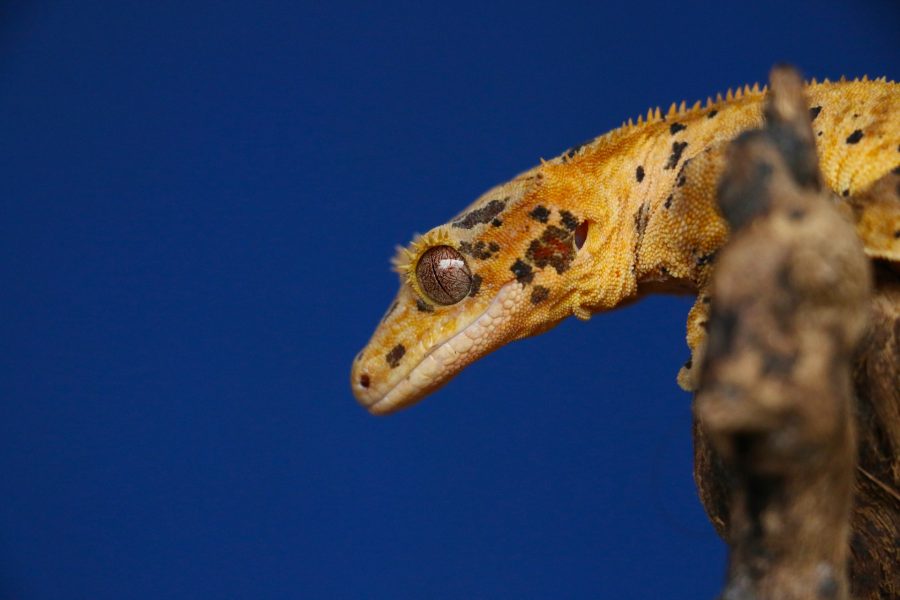The Crested Gecko has become a popular choice for reptile enthusiasts since it was introduced to the herpetoculture industry. It stands out from other geckos due to its unique variations in color, pattern & structure resulting from genetic mutations. They can be spotted with bright yellow, orange, red and even purple hues!
Alongside their physical beauty, crested geckos have unique genetics that set them apart from other lizards.
Experienced breeders have been able to improve upon traits already present in wild Crested Gecko populations through selective breeding over several generations.
This has resulted in the development of many new colors (it includes almost every color of the rainbow), morphs, and structural features.
Here, we’ll explore the different crested gecko morphs & genetics that make them stand out.
List of the Most Common Crested Gecko Morphs
Crested geckos are among the most popular reptiles for hobbyists and have become even more popular in recent years due to their wide range of color and pattern morphs.
Numerous types of crested gecko morphs in the pet trade, each with unique characteristics.
Here is a list of 13 of the most popular crested gecko morphs, from simpler and often cheaper to more exotic varieties.
- Tiger Morph
- Brindle Morph
- Bi-Color Morph
- Tricolor Morph
- Flame Morph
- Dalmatian Morph
- Harlequin/Harley Morph
- Lilly White Morph
- Lavender Morph
- Pinstripe Morph
- Phantom Morph
- Red Morph
- Yellow Morph
1. Tiger Morph
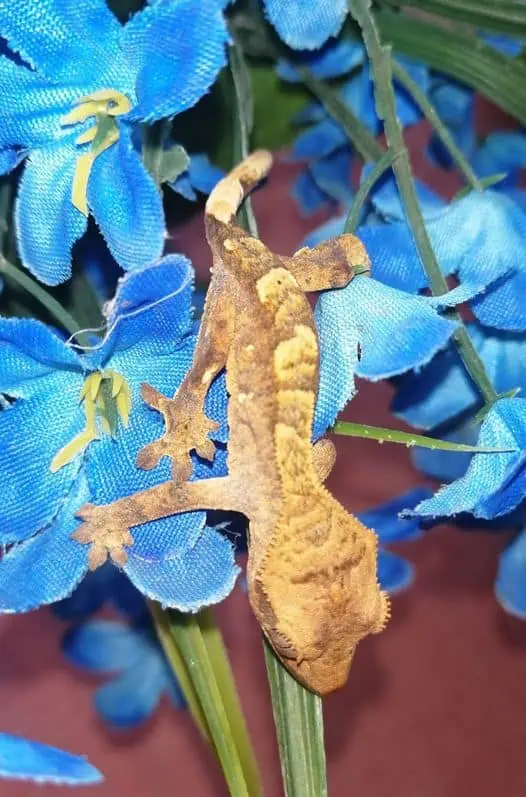
Breeding experts have refined the tiger trait for decades, giving it a special place in the crested gecko lineup.
Also, those same experts have used this unique gene to enhance other morphs like the flame, harlequin, and pinstripe.
Amazingly, even if no visible stripes are present, the tiger gene still affects how much a pattern breaks or varies along a crested gecko’s back.
2. Brindle Morph
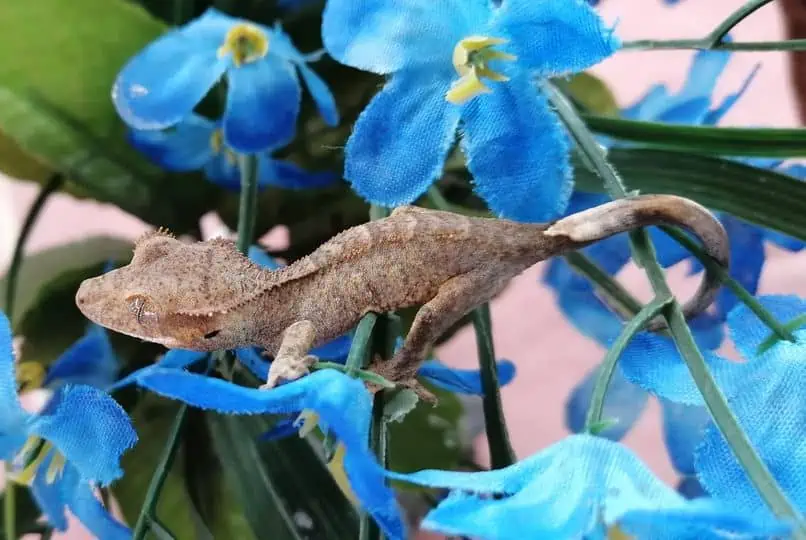
Unlike the side-to-side stripes of tigers, brindles’ markings are broken up and uneven, like marbling or lattice-work, with dark brown, orange, and red spots on their back & sides. These reptiles come in various colors – from light reds to tans and yellows, making them eye-catching!
And if you get a brindle mixed with Dalmatian, you’ll get the perfect blend of stripes and spots. These fun little creatures usually cost ~$75-300 – making them one of the more affordable morphs.
So why not add a brindle crested gecko to your collection & see for yourself? You won’t be disappointed!
3. Bi-Color Morph

Their dorsal color may have a slightly different shade than their base color. Plus, they may sport some light patterning, not enough to be classified as Dalmatian or Tiger, but more than a patternless crested gecko.
If you want to add some serious style points to your terrarium or vivarium, these are the creatures for you.
4. Tri-Color Morph
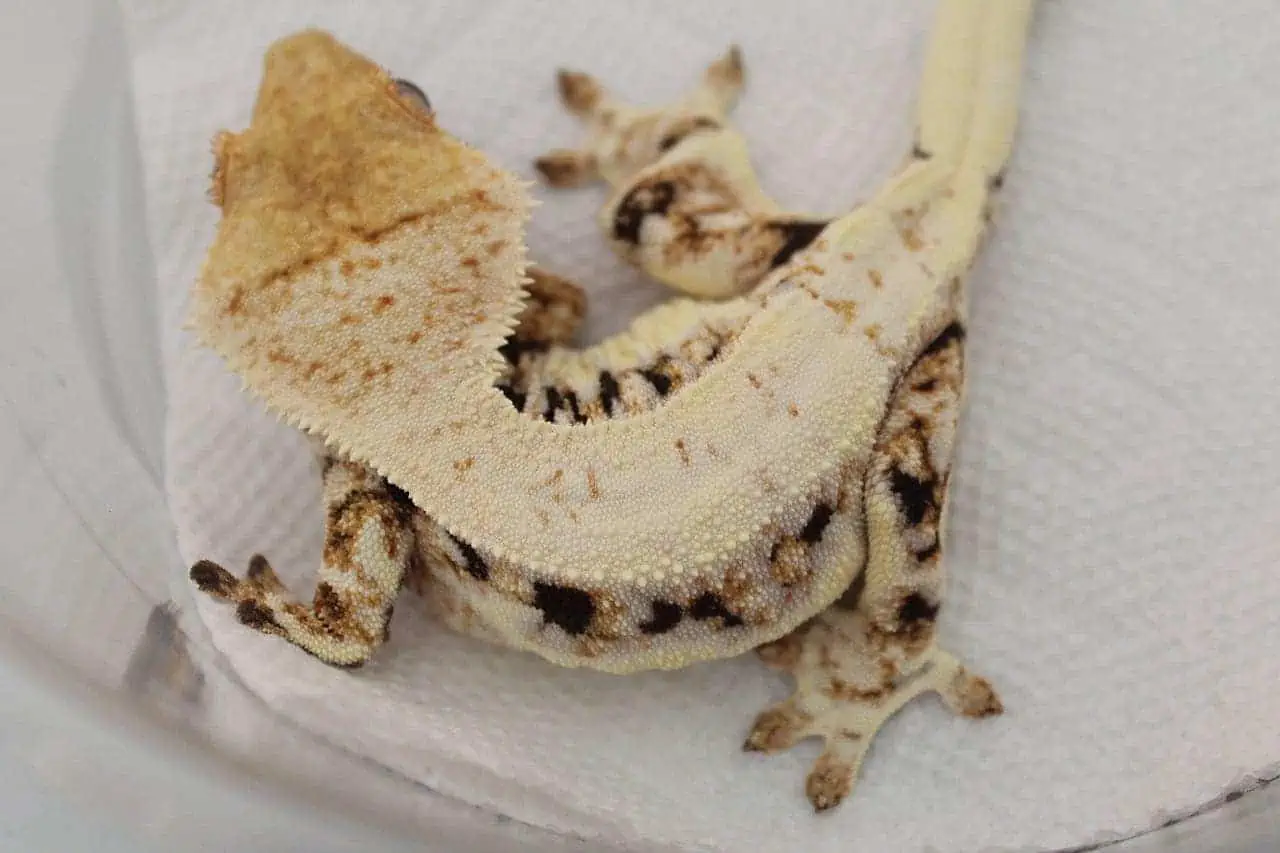
Tri-color crested gecko is one of the more popular morphs, and it lives up to its namesake with three distinct colors! It could be brown, cream, white, black, green, red, orange, or yellow, whatever color combo you prefer. The pattern on a tri-color crested gecko typically includes three distinct colors, often with a combination of solid or mottled patches, stripes, or spots.
Whether you’re just getting into crested geckos or you’ve been a fan for years, there’s something special about the tri-color morph that inspires awe.
5. Flame Morph
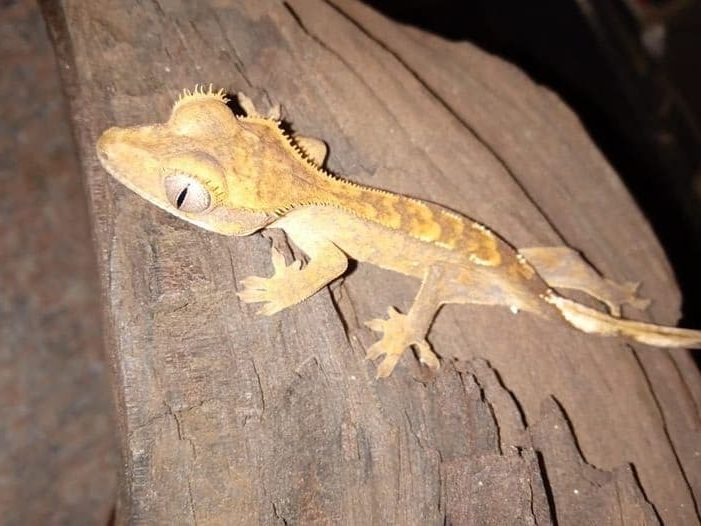
With a deep brown or red base color – they have vibrant cream, orange and yellow markings on their back and tail that look like flames dancing in the wind. You can even see these markings “firing up” when the geckos get excited or communicate with one another like a real-life fireworks show!
Plus – their markings are unique because they mostly appear on their back and tail, unlike other crested geckos, like tiger or harlequin, that have them all over.
So cool, right? 🤗
These mesmerizing beauties will leave you in awe, so don’t forget to appreciate their beauty the next time you see one!
6. Dalmatian Morph
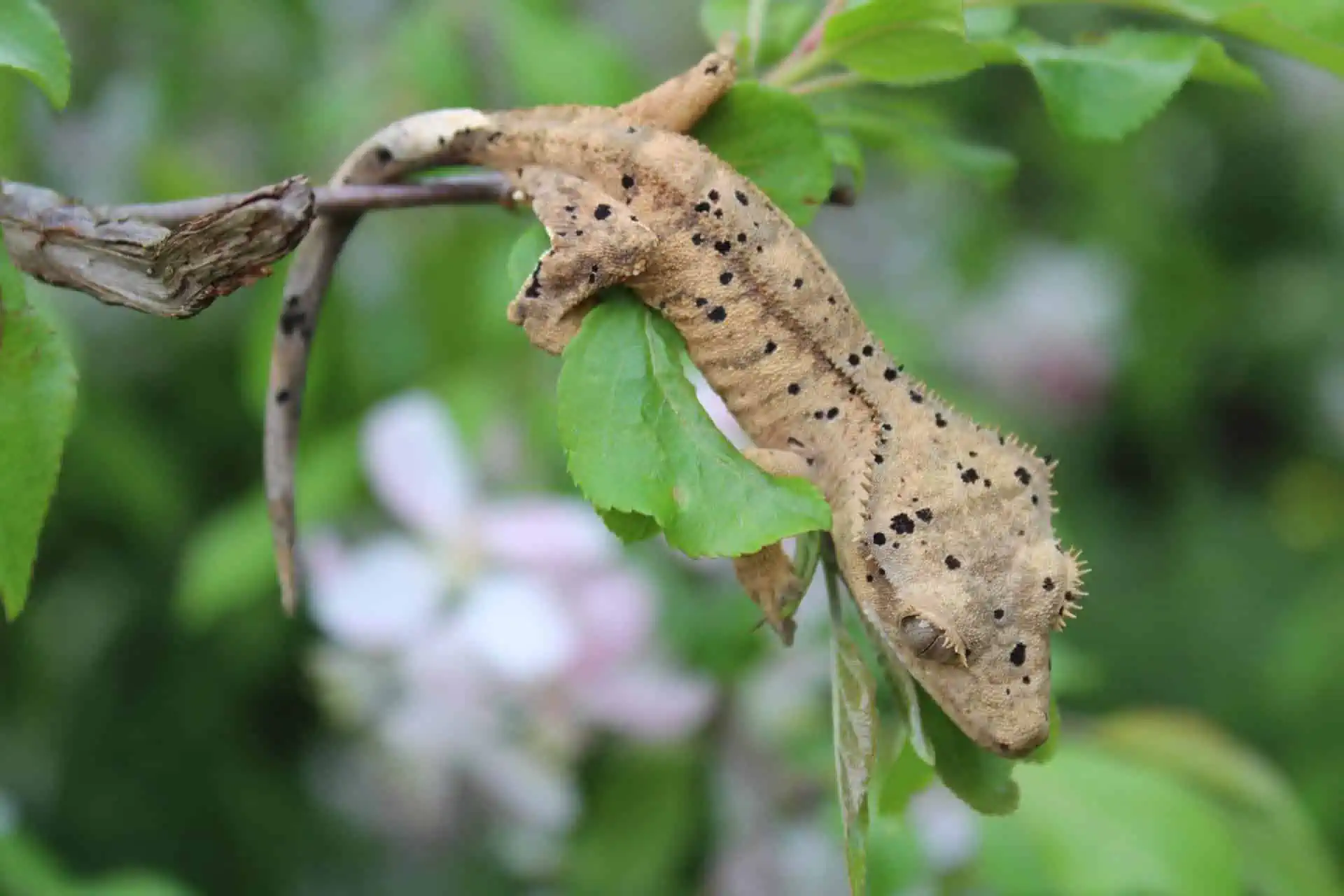
You’ve heard of Dalmatian dogs. Like them, Dalmatian crested geckos also share this patterned look with black spots from head to toe.
It’s a natural genetic trait in the wild! So all they do is add spots on top of existing morphs; no changing the base color here. Some of these little monsters have little specks of black all over their bodies, while others are almost fully covered with big black spots.
Everyone is unique, and the amount of spotting differs from gecko to gecko.
7. Harlequin/Harley Morph
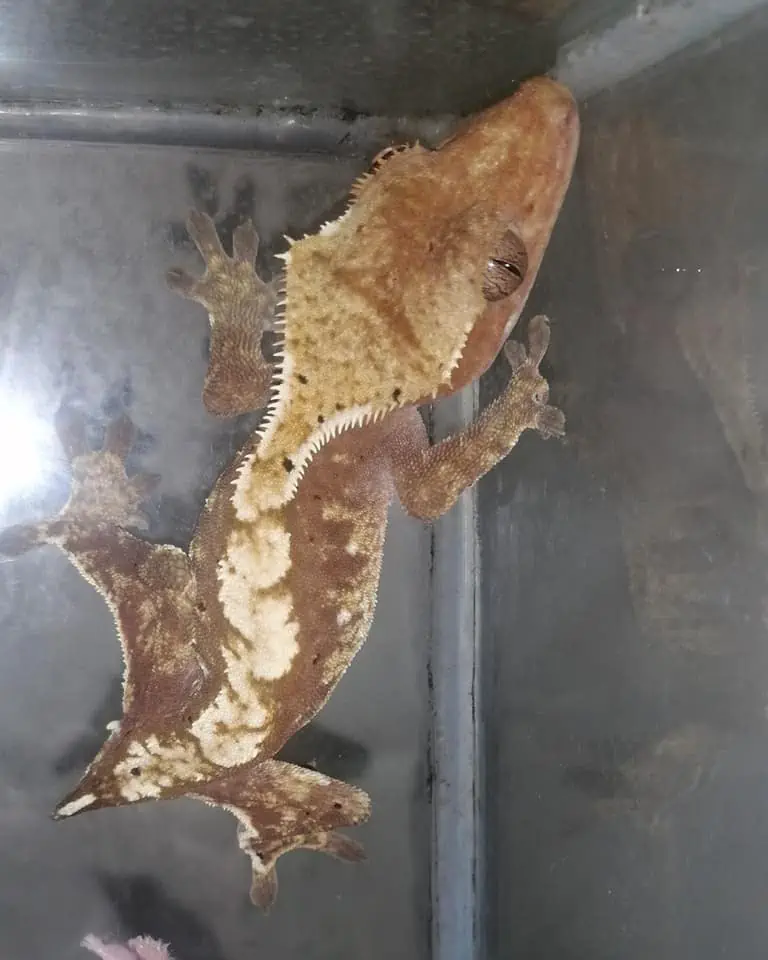
These guys look similar to the flame morph but with more patterning on their legs and tail. Though all these small creatures have the same basic dappled pattern – they come in different hues.
8. Lilly White Morph
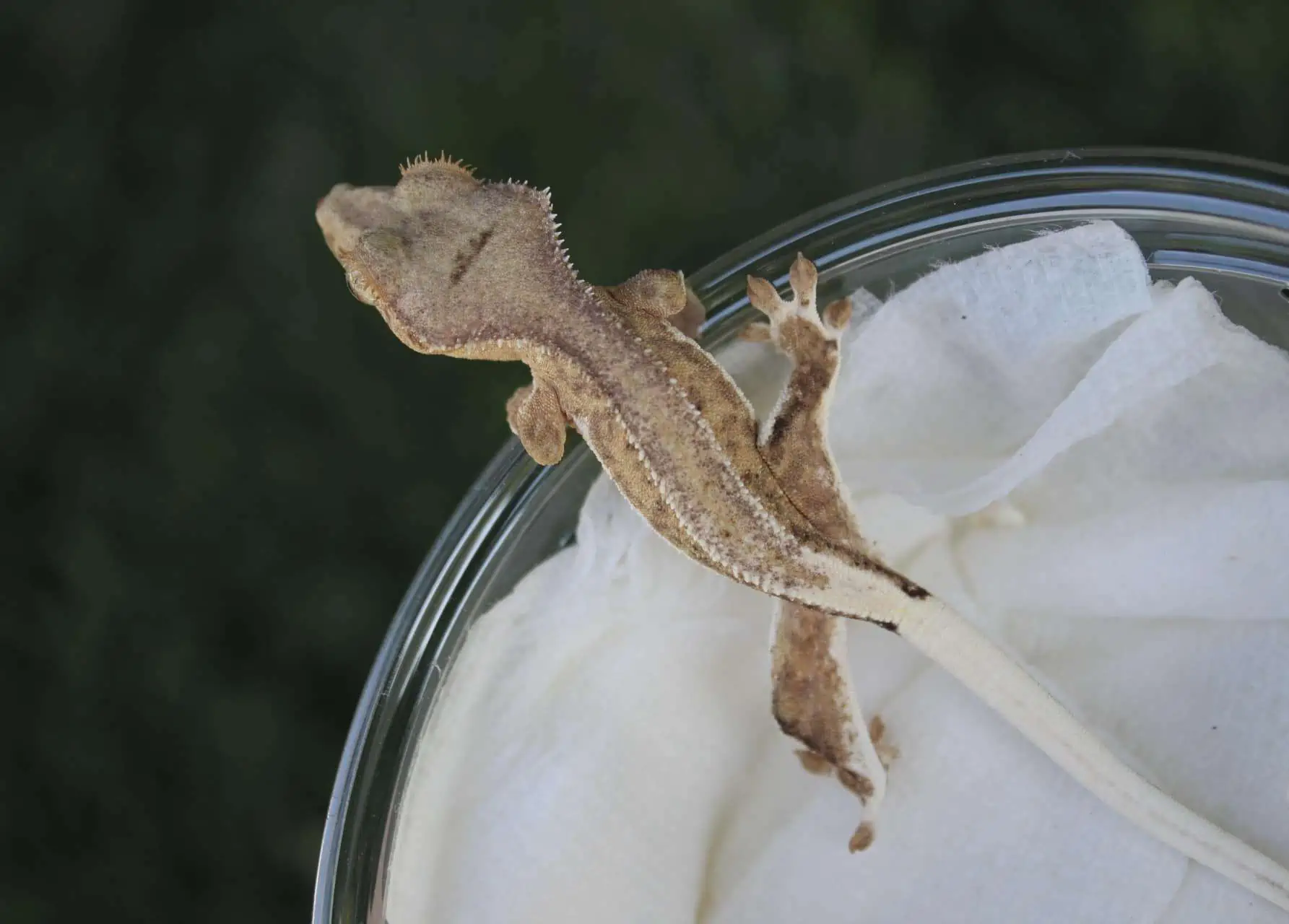
The Lilly white crested gecko is a morph that people desire because of its rarity. It has a unique white & pale cream color that is especially noticeable on its head, back, tail, and underbelly.
In addition to these colors, brown speckles are also on the sides. The Lilly white gecko was discovered in 2010 by Lilly Exotics – a UK-based breeder.
It’s a co-dominant type, so the genes are passed to the offspring when you cross it with other types.
You’d be lucky to get your hands on one of these beauties!
9. Lavender Morph
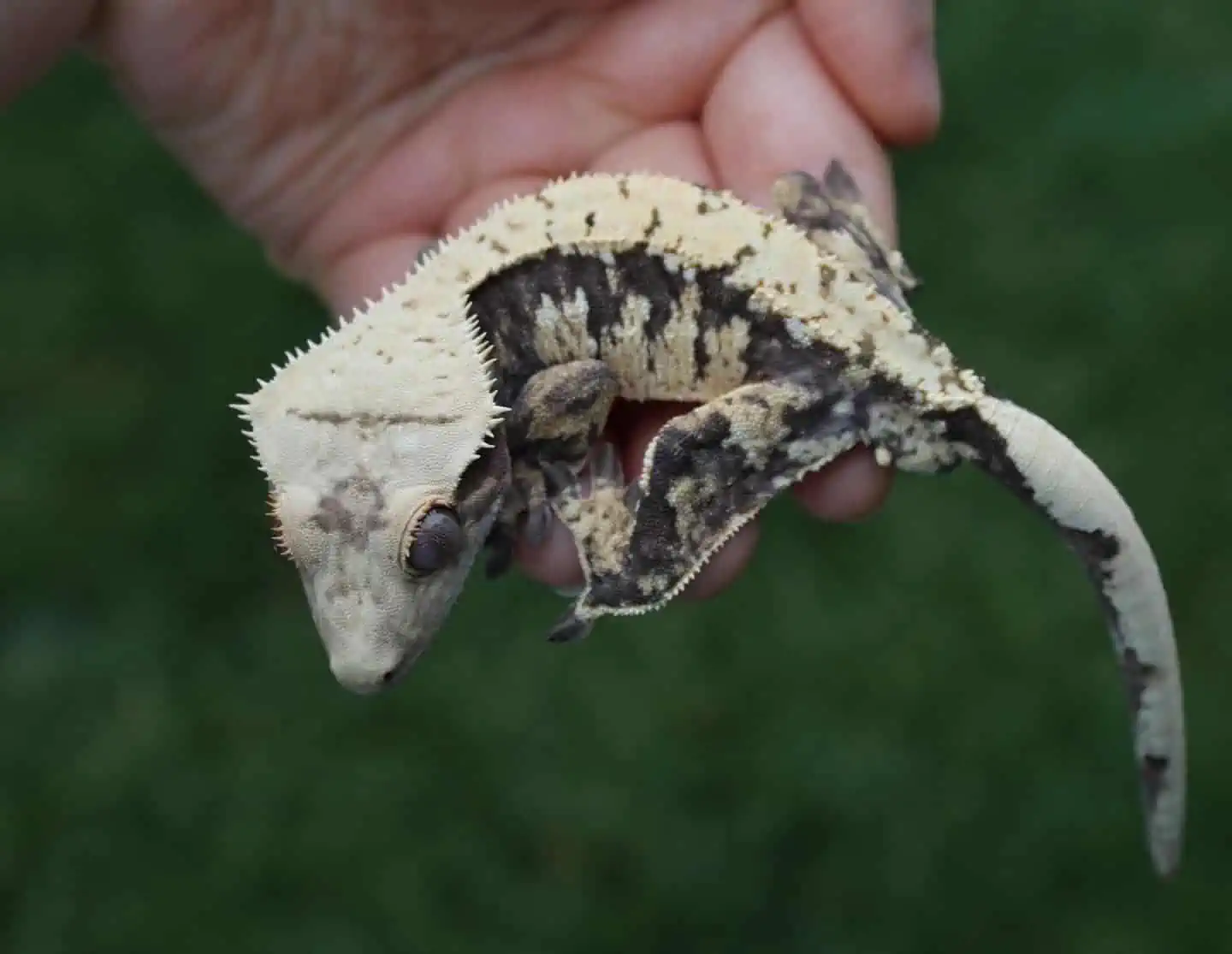
The lavender crested gecko is a stunning combination of two morphs:
- Black
- Hypomelanism
You’ll see their purplish-gray base color lighten up with any other markings, making them appear creamy white instead of the usual dark shades.
When fired down, they have a lighter, less saturated gray hue. When fired up, they take on a deeper purple shade – the signature of this morph!
It doesn’t stop there either; you can combine the lavender trait with other morphs, such as Dalmatian, snowflake, or pinstripe, and still get that beautiful purple base. It’s truly a sight to behold!
10. Pinstripe Morph
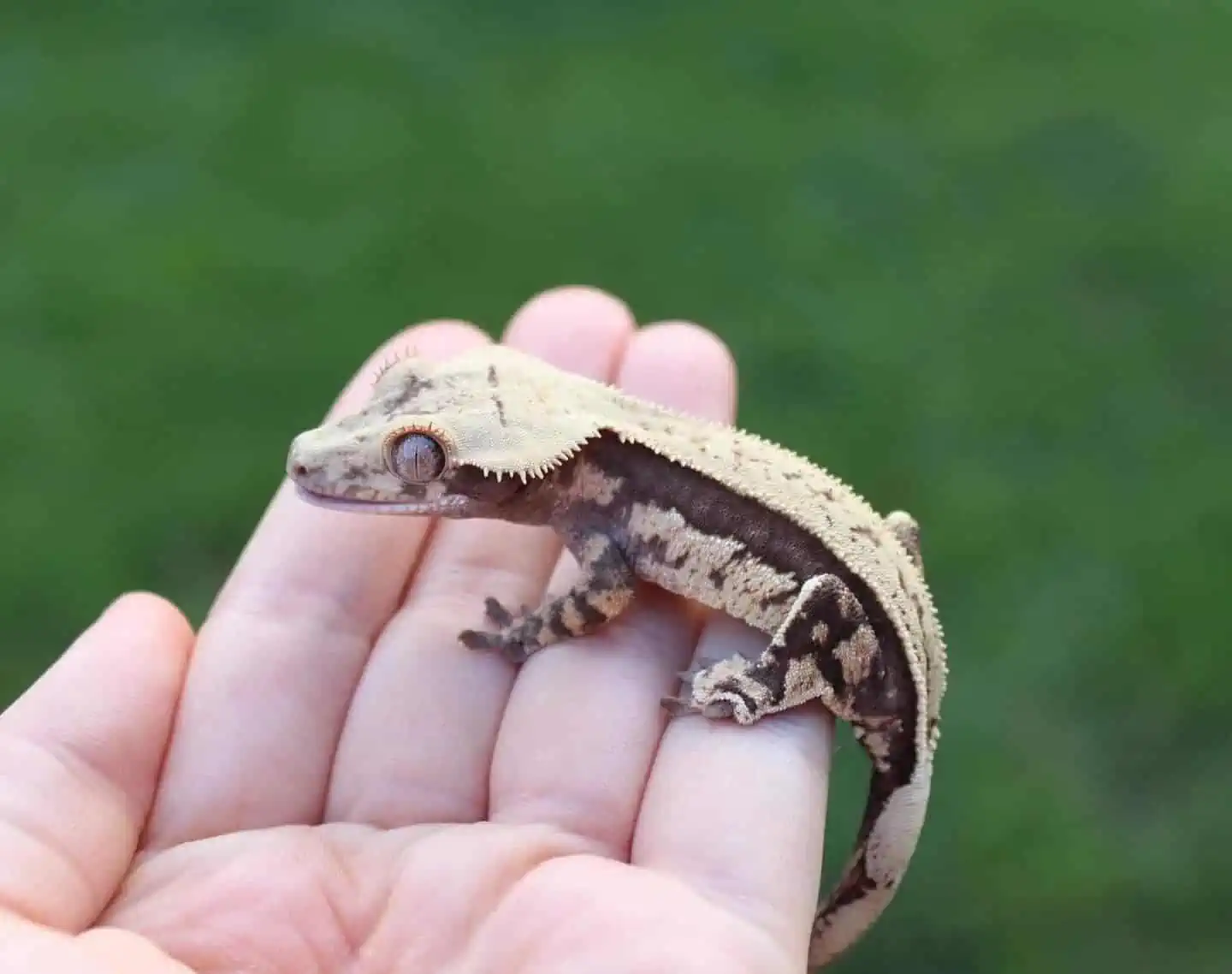
Pinstripe crested geckos have a unique feature that sets them apart from the rest:
- Two lines of pale
- Raised scales running parallel down their backs
You could call it their ‘badge of honor. ‘Pinstriping is not a true morph, but rather an individual characteristic. It comes in three forms: full, partial, or reverse pinstripes.
- Full Pinstripes: If the lines remain unbroken from their eyes to their tails, they’re said to be ‘100%’ pinstripes.
- Partial Pinstripes: A pinstripe considered partial is one where the stripes are not continuous from the head to the tail and are broken up.
- Reverse Pinstripe: Reverse pinning is a cosmetic feature that creates a shadow effect on the outside of pinstripes. It’s not a structural trait. The darker color will be visible on the top of the lateral area and just below the dorsum/pinstripe scales.
11. Phantom Morphs

The phantom crested gecko is a variety of crested gecko that alters the texture and pattern of its dorsal scales. It is also known as the phantom pinstripe.
It has two rows of dark, raised scales instead of the traditional pinstripe markings. Phantoms exhibit a dark base color with faint white patches near the base of the tail and close to the belly and muted patterns that lack flame or cream tones.
To inherit this trait, cresties must have two copies of the recessive gene. Breeding for this morph is still a work in progress and can be quite challenging.
12. Red Morph
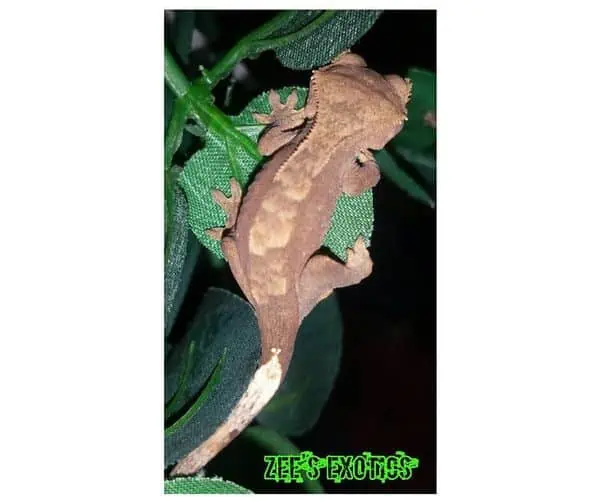
You’ll see that they boast a deep red hue, and the richer the color, the more valuable it is.
On the other hand, if its color is on the muddy or orangey-red side, with several lighter hues interspersed between them, it’s a less desirable and thus cheaper variant.
The best of the best, however, is a true red crested gecko with an even and solid hue that doesn’t have any interruption from other hues.
13. Yellow Morph
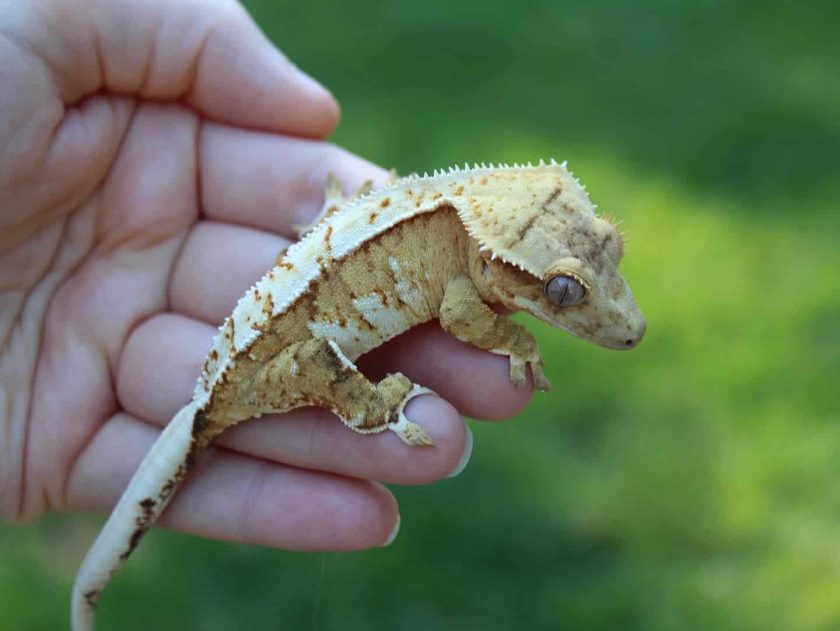
Yellow-crested geckos have a color that matches their name: yellow! This unique hue resulted from selective breeding in the early 2000s when these geckos were new to the hobby.
The best specimens have a vibrant, clean sandy yellow base shade with pale bellies and darker heads.
‘Yellow’ can describe any crested gecko with a yellowish tint or pattern, from the lightest to the darkest. This beautiful morph is found in the wild, so all that was needed was carefully choosing the brightest individuals and breeding them to bring out this hue even more.
Crested Gecko Morph Chart
| Morph | Color | Pattern |
| Tiger | Yellow, brown, orange, cream, or olive | Light to dark brown tiger-like stripes |
| Brindle | Light yellow, orange, or tan | Highly fragmented stripes consisting of shades of brown, black, and orange. |
| Bi-Color | Yellow, olive red, or brown | The top area exhibits a lighter hue, while the sides & belly feature a darker shade. |
| Tricolor | Brown, cream, white, black, green, red, orange, or yellow | The body has 3 distinct colors with a combination of solid or mottled patches, stripes, or spots. |
| Flame | Dark, brown, or red | Orange, yellow, or cream stripes |
| Dalmatian | Tan, brown, or cream | Black spots & speckles |
| Harlequin/Harley | Black, brown, or dark-orange | Cream, white or yellow mottling on sides & legs |
| Lilly White | Cream or white | Small brown spots are located on both sides of the ribcage. |
| Lavender | Lavender or pale blue-gray (when fired up) | White or cream mottling |
| Pinstripe | Orange, brown, tan, or olive | Raised stripes extend from both eyes to the tail – giving a pale appearance. |
| Phantom | Orange or dark brown | Elevated pinstripe scales & faint white markings near the tail. |
| Red | Rich red | None (or minimal patterning) |
| Yellow | Sandy yellow | Any pattern |
Crested Gecko Genetics
Crested Geckos (Correlophus ciliatus) genetics is a mystery compared to other common reptile breeding subjects like leopard geckos & ball pythons.
Natural selection seems to be playing out multiple allelism with various phenotypes. This is an advantage, as it allows for more adaptability and survival through the generations.
You can see how Mother Nature works her magic. It’s like she’s giving them a fighting chance against all odds!
Genetic Factors to Consider
Unlike leopard geckos, ball pythons & bearded dragons, the genetics of crested geckos are not similar. The morphs of other reptiles are mainly determined by dominance, recessiveness, and co-dominance genetics – which are well understood. When you mate with certain genes, you can predict the outcome.
This is not the case for crested geckos – as their genetics have not been documented yet. The traits of their offspring are less predictable and seem somewhat random and affected by external factors and living conditions. It’s all a bit of a gamble, but the parents still play a significant role in determining how their offspring will look. Off-spring inherit traits from both parents, which can result in varied appearances among siblings.
So it seems like there are many different genetic factors at play when it comes to crested geckos:
Epigenetics
When embryos are affected by environmental factors or incubation – epigenetics – which refers to changes in gene expression, may play a role in determining outcomes.
Whether or not these changes are passed down the generations is still unclear.
For Example, Scientists have observed that incubating eggs for a longer period at lower temperatures can lead to increased tail-pad & crests sizes in the offspring. Furthermore – external elements such as water, food, and temperature may also influence how a gene is expressed.
Additionally, if the parent gecko consumes food high in beta-carotene, they may pass on the trait of more vibrant red-orange-yellow colors to their offspring.
That’s epigenetics at work!
You could say that diet has a direct impact on gene expression! Pretty cool stuff, right?🧐
Polygenetics
Crest geckos exhibit a greater degree of polygenetic – meaning that several genes control their physical characteristics compared to other geckos. This could explain the observed continuous variation in traits among these cute lizards.
Traits passed down from parents to their children are usually controlled by multiple genes called “polygenes.”
Each gene, or allele, either strengthens or weakens the physical or observable characteristics of the trait, known as the phenotype.
Examples of traits controlled by polygenes include:
- The amount and variety of pinstriping
- The regions where portholes appear on the body
- Raised scales on dorsal ridges and lateral lines
- Coloration variations such as base-color matching
Expressions of Color in Crested Gecko Morphs: It may seem like a single phenomenon on the surface – but this is rarely the case. Beneath that beautiful exterior lies a complicated combination of multiple alleles that create that singular visual appearance – be it buckskin, green, brindle, or harlequin.
So – if you thought crested geckos were simply one color, think again – it’s a lot more complex than that!
To produce the desired traits, the key with crested geckos is to practice selective breeding to the best of your ability.
Proven Genes of Crested Gecko
Although most of the Crested gecko morphs are polygenic, two genes – Lilly White and Axanthic – are known to be co-dominant and recessive.
Depending on the pairing, you can predict how much of the outcome will be Lilly White or Axanthic, or het Axanthic.
That said, even with these predictions, the other parent or grandparent can still influence what color your babies will turn out. So don’t be too sure of yourself; you never know!
What Is the Most Common Crested Gecko Morph?
The “normal” or “wild-type” morph is the most common type of crested gecko. This little beast has a brown or grey base color with white or yellow spots and stripes.
This particular morph resembles the natural appearance of crested geckos found in the wild and is easily available in pet stores or from breeders.
What Is the Difference Between Crested Gecko Morphs and Lines?
In the field of breeding crested geckos – the terms “morph” and “line” refer to distinct characteristics related to the gecko’s physical appearance and genetic makeup.
As discussed earlier, morphs refer to specific color or pattern variations achieved through selective breeding.
Lines, however, identify a group of related geckos that can be traced back to a specific set of parents.
By understanding the genetics within these lines – breeders can predict the look and characteristics of their future brood, thus preserving certain traits or morphs for future generations.
So, in a nutshell, morphs are unique physical traits, while lines refer to the shared ancestry of related geckos.
Can You Breed Different Morphs of Crested Geckos?
You can breed different morphs of crested geckos to get a range of colors & patterns: an activity known as cross-breeding.
Doing so can result in a mix of parent morphs or something entirely new! But bear in mind: the genetics of crested geckos can be quite complex, so breeding them can lead to unpredictable outcomes.
That’s why it’s important only to breed healthy – genetically diverse geckos, and that should only be done by experienced – responsible keepers who know what they’re doing.
Remember that when they first hatch, they don’t often look like much, but their color and pattern will usually improve as they mature. Looking at photos of the parents can give you an idea of what to expect from their offspring!
To Sum It Up!
Crested gecko morphs possess an incredible diversity of appearances. From the mesmerizing colors of the patternless morph to the striking patterns of the white-spotted, there’s no shortage of visual marvels within the crested gecko community.
It’s interesting to note how these little reptiles result from genetic variations, with different combinations of genes influencing the gecko’s appearance.
As a pet owner or enthusiast, you can delve into the world of genetics and witness the magic of breeding as you strive to create new & unique morphs.
Which morph from the list intrigued you the most? – Are there any questions you have regarding crested gecko morphs and genetics? Let us know in the comments below!🤗

